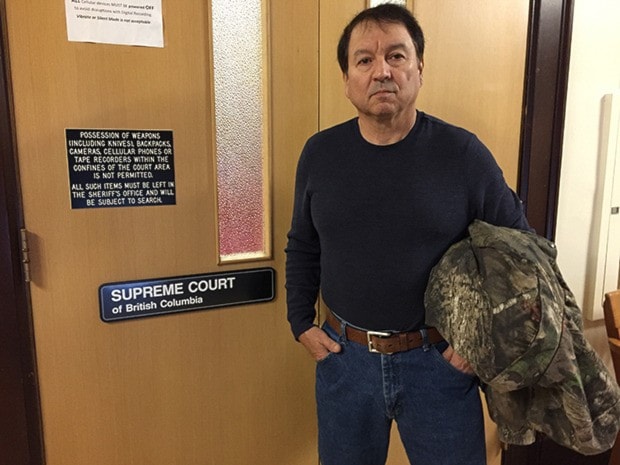Final arguments were heard at the Nelson courthouse this week in a historic aboriginal rights trial that hinges on whether or not someone of Sinixt ancestry has the right to hunt on either side of the border.
U.S. hunter Richard Desautel was charged in 2010 with hunting without a licence and hunting big game while not being a resident, but pled not guilty based on his indigenous rights to hunt for food, social and ceremonial purposes.
He shot an elk near Castlegar, didn’t have a hunting license, and has never been a resident of B.C. But by asserting these rights he hopes to “erase the terminology of extinction and get the government to acknowledge the Sinixt are still here.”
“I’ll take this fight as far as I can,” he told the Star.
Crown prosecutor Glen Thompson and defence lawyer Mark Underhill laid out their arguments for Judge L. Mrozinsky on Tuesday and Wednesday following a three-week trial in which Sinixt elders, aboriginal scholar Dr. Dorothy Kennedy, ethnology expert Dr. Andrea Laforet and historian Richard Hart gave testimony.
The main issues explored included whether granting an American aboriginal rights north of the border would challenge Canadian sovereignty and whether or not the Sinixt are what the lawyers called a "rights-bearing group” in Canada.
Who is or isn’t Sinixt?
According to defence lawyer Mark Underhill, Sinixt identity is defined by more than where they currently live. And though the vast majority of self-identified members of the Sinixt currently live in the U.S., as part of the Colville Confederated Tribes, he said that shouldn’t negate their rights in Canada.
“The Crown focuses on the move,” he said. “They’ll say there are no Sinixt in Canada today.”
But that’s not the case, according to his submission. He described a “Sinixt diaspora” in which “common threads of culture” hold together an otherwise disparate and disconnected group. He pointed to Desautel’s family tree as proof that he belonged to it.
Underhill argued that the members of this diaspora, though officially extinct in Canada according to the federal government, are covered under Section 35 of the Constitution, which sets out the definition of aboriginal rights and who is covered by them.
“It’s not the court’s job to tell the Sinixt who they are, or to decide who is or isn’t Sinixt. The court cannot say Richard Desautel is not Sinixt.”
He said the Sinixt’s traditional territory north of the border has remained important to them, and the tribe’s move was involuntary, following the influx of European settlers and epidemic diseases. And even though they left, he said that shouldn’t mean their rights ceased to exist.
“There is no example in North America of an indigenous group giving up their culture voluntarily,” he said, urging the judge to consider the implications of her decision.
“You would be saying to the people, some sitting here in this gallery, that you don’t have an identity anymore because you moved and you cannot carry out your culture in your ancestral homeland. That’s the practical consequence of this decision.”
‘You can’t create a shadow Sinixt community’
The main thrust of prosecutor Glen Thompson’s argument was that the Sinixt voluntarily moved south and that one person can’t claim rights from two different tribes. Furthermore, he said he disagrees that the Sinixt diaspora described by Underhill can be “objectively defined."
“There’s this idea that Sinixt can live anywhere, without roots or a geographic community to live in. But this geographically diverse collective does not have any centralized organization, it has disparate individuals making their decisions.”
And many of the people claiming Sinixt ancestry are also members of other tribes, bringing up the question of whether they can “bundle” their rights or if they have to choose one or the other.
“You can’t create a shadow Sinixt community,” he said.
Referring to the research and testimony given over the course of the trial, Thompson described how a Sinixt migration started in 1830.
“I’m going to take you through the history and show how and why the move occurred entirely voluntarily, and that it was virtually complete by the 1890s.”
However, Judge Mrozinsky took issue with his assertion that the examples given demonstrated the move was voluntary, and said “this is about catastrophic change. This is like aliens coming to Earth.”
She reminded the Crown that it has a duty to take part in the Truth and Reconciliation process, and needs to keep in mind the devastating effect European settlers had on First Nations upon arrival, including the spread of diseases like smallpox.
‘This is a historic trial’
Desautel was in attendance during the closing arguments, along with tearful members of his tribe. He feels confident about his chances, but figures the fight will proceed to a higher court.
“We started at the first floor, now we’re on the third, so we’re going to keep going up,” he said. “I think this is really necessary for future generations of my people. This is a historic trial.”
He would “like to have a say on what’s going on in this part of the world with our ancestral grounds. The pithouses, the pictographs, they are all over this country and people who have moved here have no idea what their significance is to me and my people.”
As far as he’s concerned, this case is about much more than one person.
“This is way bigger than me. This is about the generation after me and the generation after them.”
